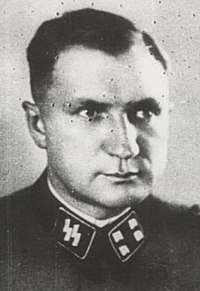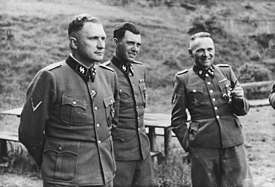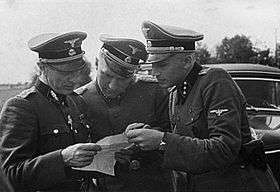Richard Baer
Richard Baer (9 September 1911 – 17 June 1963) was a German SS commander who was the commandant of the Auschwitz I concentration camp from May 1944 to February 1945. As well as the commandant of Nordhausen-Dora from February 1945- April 1945. Following the war, Baer lived under an assumed name to avoid prosecution but was recognized and arrested in 1960. He died in detention before he could stand trial.
Richard Baer | |
|---|---|
 | |
| Born | 9 September 1911 |
| Died | 17 June 1963 (aged 51) Frankfurt am Main, Hesse, West Germany |
| Nationality | German |
| Known for | Commander of the Auschwitz I concentration camp (May 1944 to February 1945) |
| Political party | National Socialist German Workers' Party |
Life

Baer was born in Floss, Bavaria in 1911. Originally a trained confectioner, he became a guard in Dachau concentration camp after becoming unemployed in 1930. He was a member of NSDAP (no. 454991) and the SS (no. 44225). In 1939, he joined the SS-Totenkopfverbände, and was appointed adjutant of Neuengamme concentration camp in 1942 following spells in Oranienburg, Columbia-Haus and Sachsenhausen. At Neuengamme he participated in the killing of Soviet prisoners of war in a special gas chamber and in the selection of prisoners for the so-called Operation 14f13 in the T-4 Euthanasia Program.

From November 1942 until May 1944, Baer was adjutant of SS-Obergruppenführer Oswald Pohl, then chief of the Wirtschaftsverwaltungshauptamt (SS office of economic policy). In November 1943, he took over the department D I, the "inspectorate for concentration camps". He succeeded Arthur Liebehenschel, considered by Himmler to be too "soft" with the prisoners, as the third and final commandant of Auschwitz from May 11, 1944, until the final dissolution of the camp in early 1945.
From November 1943 until the end of 1944 Fritz Hartjenstein and Josef Kramer were responsible for the extermination camp Auschwitz II, Birkenau, so that Baer was only Commandant of this part of the camp from the end of 1944 until January 1945. Near the end of the war Richard Baer, having replaced Otto Förschner as commandant of the Dora-Mittelbau camp in Thuringia Nordhausen, was responsible for the execution of Soviet prisoners at mass gallows. His final rank was SS-Sturmbannführer (Major)
Post war
At the end of the war, Baer fled and lived near Hamburg as Karl Egon Neumann, a forestry worker. In the course of investigation in the Frankfurt Auschwitz Trials a warrant for his arrest was issued in October 1960 and his photograph was printed in newspapers.
The story of Baer's arrest is vividly recounted by Devin Pendas in his book The Frankfurt Auschwitz Trial.[1] After seeing a wanted picture in the Bild-Zeitung, a co-worker on Otto von Bismarck's estate reported that Baer was working as a forester there. When officials confronted "Neumann" in the forest on the early morning of December 20, 1960, he at first denied everything. Having already addressed Baer as her "husband", the woman in the house subsequently gave her name as "Frau Baer", but still claimed that Baer was named Neumann. Baer, however, finally admitted his true identity. On the advice of his lawyer, he refused to testify. He died of a heart attack in pre-trial detention in 1963.
Notes
- Pendas, David (2006) The Frankfurt Auschwitz Trial, 1963-1965: Genocide, History and the Limits of the Law. Cambridge University Press, p. 48. ISBN 9780521127981
References
- Karin Orth: Die Konzentrationslager-SS. Sozialstrukturelle Analysen und biographische Studien. dtv 34085, München 2004 ISBN 3-423-34085-1 (Todesursache: S. 290, Anm. 68)
- Tom Segev: Die Soldaten des Bösen. Zur Geschichte der KZ-Kommandanten. Rowohlt, Reinbek bei Hamburg 1995, ISBN 3-499-18826-0.
- Ernst Klee: Das Personenlexikon zum Dritten Reich: Wer war was vor und nach 1945. Fischer-Taschenbuch-Verlag, Frankfurt am Main 2005, ISBN 3-596-16048-0.
- Jens-Christian Wagner: Produktion des Todes: Das KZ Mittelbau-Dora, Wallstein Verlag, Göttingen 2001, ISBN 3-89244-439-0.
External links
- Richard Baer on the Jewish Virtual Library
- Karl Hoecker’s Album slideshow on The New Yorker's website
- Picturing Auschwitz